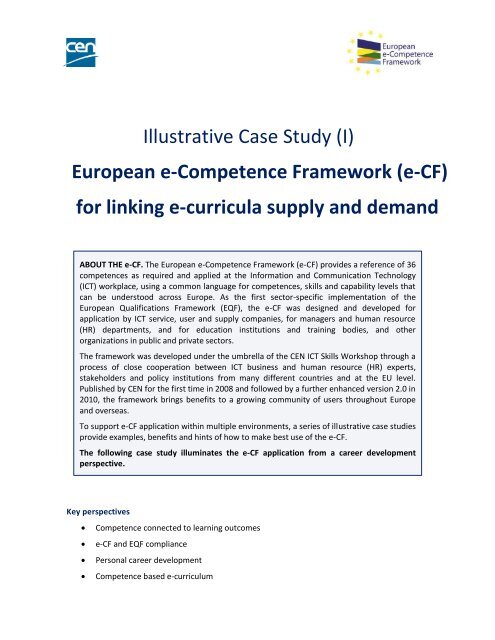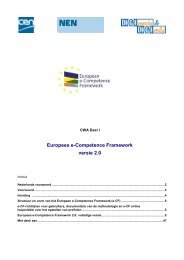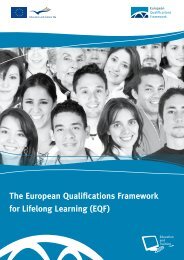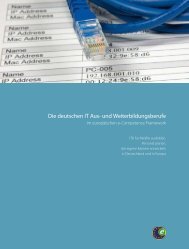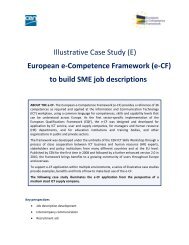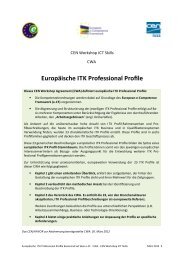download - European e-Competence Framework
download - European e-Competence Framework
download - European e-Competence Framework
You also want an ePaper? Increase the reach of your titles
YUMPU automatically turns print PDFs into web optimized ePapers that Google loves.
Illustrative Case Study (I)<br />
<strong>European</strong> e-<strong>Competence</strong> <strong>Framework</strong> (e-CF)<br />
for linking e-curricula supply and demand<br />
ABOUT THE e-CF. The <strong>European</strong> e-<strong>Competence</strong> <strong>Framework</strong> (e-CF) provides a reference of 36<br />
competences as required and applied at the Information and Communication Technology<br />
(ICT) workplace, using a common language for competences, skills and capability levels that<br />
can be understood across Europe. As the first sector-specific implementation of the<br />
<strong>European</strong> Qualifications <strong>Framework</strong> (EQF), the e-CF was designed and developed for<br />
application by ICT service, user and supply companies, for managers and human resource<br />
(HR) departments, and for education institutions and training bodies, and other<br />
organizations in public and private sectors.<br />
The framework was developed under the umbrella of the CEN ICT Skills Workshop through a<br />
process of close cooperation between ICT business and human resource (HR) experts,<br />
stakeholders and policy institutions from many different countries and at the EU level.<br />
Published by CEN for the first time in 2008 and followed by a further enhanced version 2.0 in<br />
2010, the framework brings benefits to a growing community of users throughout Europe<br />
and overseas.<br />
To support e-CF application within multiple environments, a series of illustrative case studies<br />
provide examples, benefits and hints of how to make best use of the e-CF.<br />
The following case study illuminates the e-CF application from a career development<br />
perspective.<br />
Key perspectives<br />
<strong>Competence</strong> connected to learning outcomes<br />
e-CF and EQF compliance<br />
Personal career development<br />
<strong>Competence</strong> based e-curriculum
e-CF FOR LINKING e-CURRICULA SUPPLY AND DEMAND PAGE 2 / 6<br />
Summary<br />
This case study illustrates how the supply of competence development education can be aligned to<br />
the demands of an ICT professional seeking career progression.<br />
From the ICT Professional’s view<br />
Petra is a young ICT professional with 7 years experience in an underwear manufacturing company<br />
of about 20 people who work on the product design, supply chain, marketing & sales, administration<br />
offices, and operate with a network of about 10 production sites across the world. Four years ago<br />
Petra developed the IS architecture in support of work process integration and management along<br />
the supply chain and for 3 years she has had ultimate responsibility for the strategic direction of<br />
technology choices. She is now regarded as the IT manager, making decisions about IT solutions and<br />
coordinating a team of two people administrating the IT system. About 9 years ago, Petra took a<br />
degree in software engineering, she started to work in a software house developing business<br />
applications and meanwhile she attended a two years executive master course in business<br />
administration. After that, she found a job in the company where she still works. She was asked to<br />
cooperate in redesign of the IS together with the then IT manager responsible and to develop it.<br />
When he retired, she assumed sole responsibility for this activity.<br />
Now, the company has just taken over another enterprise producing sportswear with a different<br />
network of production sites and clients.<br />
Within a year, a new information system must be deployed, integrating the new requirements from<br />
the changing organization, based on a long-term strategic perspective for the business.<br />
Petra is required to take responsibility for conceiving and designing the new IS architecture,<br />
together with the owner and the marketing & sales office, committing its development and<br />
implementation to an agile external software house.<br />
She will need to anticipate long-term business requirements and determine the IS model in line with<br />
organisation policy. Make strategic IS policy decisions for the enterprise, including sourcing<br />
strategies.<br />
Petra has a short time to boost her competence that she has started to develop on the job, it needs<br />
to be enhanced, consolidated and systematically developed through a training course. As an<br />
additional challenge she will have to cope with a new market and the IS will have to align to new<br />
business needs and WEB paradigms.<br />
From the Vocational Training Provider’s view<br />
The recently established Vocational Training School of ICT <strong>Competence</strong>s intends to deliver<br />
competence-based training programmes, aiming for learning outcomes that integrate both technical<br />
and behavioural e-skills.<br />
The e-CF meets their requirements as it is structured upon e-competences, intended as<br />
“demonstrated abilities to apply knowledge, skills and attitudes for achieving observable results”,<br />
and building blocks to develop ICT job profiles.<br />
Accordingly, the provider has elaborated 36 learning modules, one for each of the 36 e-<br />
competences included in the e-CF. The learning modules can be the elements used to build up new<br />
further and more complex learning modules and outcomes.<br />
Learning modules have a value per sé, and they can be followed one by one, apart, or as subsets of<br />
more complex learning modules.<br />
e-CF CASE STUDY – I CEN ICT SKILLS WORKSHOP www.ecompetences.eu www.cen.eu
e-CF FOR LINKING e-CURRICULA SUPPLY AND DEMAND PAGE 3 / 6<br />
Matching offer and demand<br />
Searching the internet for possible matching learning initiatives, Petra searched with some key<br />
words such as, “Information System, architecture design, business strategy…. “. The first outcome in<br />
the search engine was the <strong>European</strong> e-<strong>Competence</strong> <strong>Framework</strong>. Petra became curious and opened<br />
the reference page. The list of the 36 e-competences appeared and just the first one was: A.1. IS<br />
and Business Strategy Alignment. She became more and more inquisitive. She clicked on, and a<br />
description of that competence, with its levels and examples of knowledge and skills, was shown.<br />
Nearby, the indication of the vocational school providing the related learning module was<br />
publicized. It was the only one. So Petra learnt more about that institution, got information about<br />
their training offer, and attended the course. Now she feels ready to start the challenging task<br />
proposed by her company.<br />
e-CF Value<br />
The e-CF is EQF compliant, it is a suitable reference framework for competences to be dealt with as<br />
learning outcomes. Moreover, each e-competence is constructed and described with its<br />
components and levels. Accordingly, the e-CF can be a good input for developing learning modules.<br />
Its modular structure allows us to combine different e-competences and their elements to build<br />
learning units and modules.<br />
Challenges encountered<br />
There are no standard guidelines on how to use e-competences as learning outcomes and how to<br />
use the set of e-competences and their components to build up learning modules. Moreover, e-<br />
competences are not based on hierarchical relationships; consequently, there is no implicit<br />
progression to be followed to combine the building blocks. Furthermore, guidelines on learning<br />
module duration and the balance between theory and practice are not available, they would be<br />
useful to harmonize the different programmes and for construction of a transparent rationale.<br />
Additionally specifications of teaching staff as well as entry requirements to attend the learning<br />
modules, pathways and credits, have not been established.<br />
Benefits highlighted<br />
The e-CF was created as an answer to the stakeholders’ request for a shared <strong>European</strong> framework of<br />
competences in the ICT business areas. Accordingly, the e-CF provides the reference content for<br />
vocational training in the ICT sector.<br />
The e-CF has adopted the <strong>European</strong> Qualifications <strong>Framework</strong> grammar and it is built upon the<br />
principle of “operational descriptions”, namely observable and measurable descriptions, as<br />
learning outcomes themselves are. Through analysis of Dimension 3, the e-CF is able to suggest<br />
both the content, namely the learning outcomes to be developed within learning modules, and<br />
the learning units included in the learning modules; and the method as well. The closer the e-<br />
competences are to complex behaviours, including soft-contextual-managerial skills, the more<br />
valuable experiences become.<br />
e-CF CASE STUDY – I CEN ICT SKILLS WORKSHOP www.ecompetences.eu www.cen.eu
e-CF FOR LINKING e-CURRICULA SUPPLY AND DEMAND PAGE 4 / 6<br />
The method adopted<br />
This paragraph focuses on the method adopted to identify the content to be included in a learning<br />
module and possible entry e-competences. It won’t deal with its development in terms of length,<br />
academic staff specifications or didactic approach. It uses e-competence A.1. IS and Business<br />
Strategy Alignment, as an example.<br />
Step 1: Analysing the meaning of the target e-competence (A1)<br />
The analysis starts from descriptions at Dimensions 2 and 3 and can be supported by examples at<br />
Dimension 4 and the deliverables identified in the ICT Professional Profiles CWA 16458.<br />
Dimension 2:<br />
Anticipates long term business requirements and determines the IS model in line with<br />
organisation policy.<br />
Makes strategic IS policy decisions for the enterprise, including sourcing strategies<br />
Dimension 3:<br />
Level 4: Provides leadership for the construction and implementation of long term<br />
innovative IS solutions.<br />
Level 5: Provides IS strategic leadership to reach consensus and commitment from the<br />
management team of the enterprise.<br />
Dimension 4 (Only as examples):<br />
Knows/ Aware of/ Familiar with:<br />
K1 business strategy concepts<br />
K2 trends and implications of ICT internal or external developments for typical organisations<br />
K3 the potential and opportunities of relevant business models<br />
K4 the business aims and organisational objectives<br />
K5 the issues and implications of sourcing models<br />
Able to:<br />
S1 analyse future developments in business process and technology application<br />
S2 determine requirements for processes related to ICT services<br />
S3 identify and analyse long term user/ customer needs<br />
S4 contribute to the development of ICT strategy and policy<br />
S5 contribute to the development of the business strategy<br />
At this step, the ICT Professional Profiles report (CWA 16458) can help identifying the main<br />
deliverables expected from the reference e-competences.<br />
In this case, Deliverables are: ICT model, ICT Strategy Implementation, IS Department and Budget,<br />
Business Requirements.<br />
e-CF CASE STUDY – I CEN ICT SKILLS WORKSHOP www.ecompetences.eu www.cen.eu
e-CF FOR LINKING e-CURRICULA SUPPLY AND DEMAND PAGE 5 / 6<br />
Step 2: Checking the bonds with other e-<strong>Competence</strong>s and the learning path<br />
Most e-competences have mutual relationships. Highlighting such relationships and the tightest<br />
correspondences facilitates the identification of the set of possible content to be included in the<br />
learning module and likewise, the learning path to be undertaken.<br />
With respect to A.1., the main bonds are with A.5. on the one hand, and with E.5., E.7, on the other<br />
hand. Namely, A.5. levels 3-4; E.5., E.7., levels 3.<br />
In E.9. Dimension 4, we can find some components useful for A.1., too.<br />
A.3. and B.1. can be entry e-competences for LM A.1.<br />
Step 3: Identifying the content areas / the learning units<br />
The macro-content areas can be identified together with the related learning units and learning<br />
outcomes, composing the learning module LM A.1. IS and Business Strategy Alignment, e-4, e-5.<br />
They will come out of the e-competence descriptions at Dimension 2 and 3 with the related<br />
deliverables (Step 1), and the tightest relations with other competences (Step 2).<br />
LM. A.1. IS and Business Strategy Alignment, e-4, e-5 EXAMPLE<br />
Unit A.1.1: Technology Applications and Innovation<br />
Unit A.1.2: Business strategies and Market trends<br />
Unit A.1.3: The business context and the business organisation<br />
Unit A.1.4: The IT infrastructure, new ICT solutions and their impacts on the business<br />
Unit A.1.5: Architecture frameworks, architecture requirements: performance, maintainability,<br />
extendibility, scalability, availability, security and accessibility<br />
Unit A.1.6: Cost and Risk analysis<br />
Unit.A.1.7: Budgeting<br />
Unit A.1.8: Leadership and Communication<br />
……<br />
Step 4: Building the learning outcomes: a possible example<br />
Each Learning Unit composing the learning module is to be developed with a set of learning<br />
outcomes.<br />
Hereafter, as an example, one of the 8 learning units is broken down into learning outcomes.<br />
Unit A.1.3: The business context and the business organisation EXAMPLE<br />
<br />
<br />
<br />
<br />
<br />
Understanding the business context<br />
Understanding organisational models<br />
Case study: Defining the business context of my company<br />
Analysing business processes and designing organisational systems<br />
Case study: Designing the organisational model of my company (…..)<br />
e-CF CASE STUDY – I CEN ICT SKILLS WORKSHOP www.ecompetences.eu www.cen.eu
e-CF FOR LINKING e-CURRICULA SUPPLY AND DEMAND PAGE 6 / 6<br />
Expansion to other examples<br />
The above-mentioned case illustrated how the e-CF has been used as a reference to develop<br />
learning modules based on e-competences.<br />
Within this context, the e-CF can also support:<br />
<br />
<br />
ICT professionals to show them what to be learnt and possible learning paths<br />
Enterprises to investigate possible learning paths for competence growth<br />
References<br />
<br />
A useful reference can be found in CEN - CWA 15983 “e-CF int SME’s”<br />
See http://www.cen.eu/cen/Products/CWA/Pages/default.aspx for CWA access<br />
A family of 23 Typical <strong>European</strong> ICT Professional Profiles has been established based on e-<br />
<strong>Competence</strong>s and work deliverables. Details are available on the e-CF website, follow this<br />
link, http://www.ecompetences.eu/2165,ICT+Professional+Profiles.html<br />
e-CF CASE STUDY – I CEN ICT SKILLS WORKSHOP www.ecompetences.eu www.cen.eu


